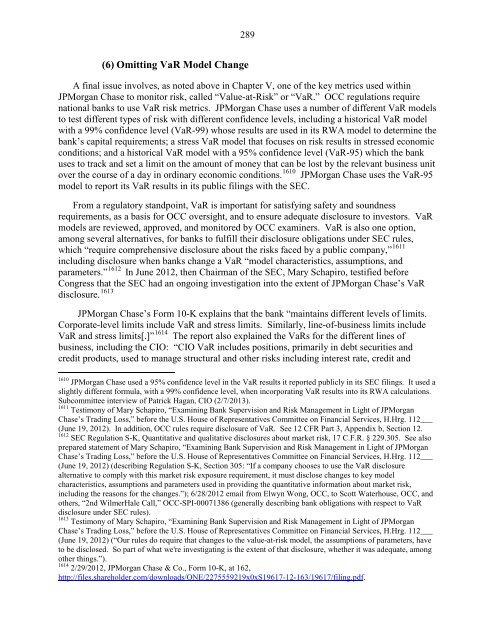JPMORGAN CHASE WHALE TRADES: A CASE HISTORY OF DERIVATIVES RISKS AND ABUSES
JPMORGAN CHASE WHALE TRADES: A CASE HISTORY OF DERIVATIVES RISKS AND ABUSES
JPMORGAN CHASE WHALE TRADES: A CASE HISTORY OF DERIVATIVES RISKS AND ABUSES
You also want an ePaper? Increase the reach of your titles
YUMPU automatically turns print PDFs into web optimized ePapers that Google loves.
289<br />
(6) Omitting VaR Model Change<br />
A final issue involves, as noted above in Chapter V, one of the key metrics used within<br />
JPMorgan Chase to monitor risk, called “Value-at-Risk” or “VaR.” OCC regulations require<br />
national banks to use VaR risk metrics. JPMorgan Chase uses a number of different VaR models<br />
to test different types of risk with different confidence levels, including a historical VaR model<br />
with a 99% confidence level (VaR-99) whose results are used in its RWA model to determine the<br />
bank’s capital requirements; a stress VaR model that focuses on risk results in stressed economic<br />
conditions; and a historical VaR model with a 95% confidence level (VaR-95) which the bank<br />
uses to track and set a limit on the amount of money that can be lost by the relevant business unit<br />
over the course of a day in ordinary economic conditions. 1610<br />
JPMorgan Chase uses the VaR-95<br />
model to report its VaR results in its public filings with the SEC.<br />
From a regulatory standpoint, VaR is important for satisfying safety and soundness<br />
requirements, as a basis for OCC oversight, and to ensure adequate disclosure to investors. VaR<br />
models are reviewed, approved, and monitored by OCC examiners. VaR is also one option,<br />
among several alternatives, for banks to fulfill their disclosure obligations under SEC rules,<br />
which “require comprehensive disclosure about the risks faced by a public company,”<br />
including disclosure when banks change a VaR “model characteristics, assumptions, and<br />
parameters.” 1612 In June 2012, then Chairman of the SEC, Mary Schapiro, testified before<br />
Congress that the SEC had an ongoing investigation into the extent of JPMorgan Chase’s VaR<br />
disclosure. 1613<br />
JPMorgan Chase’s Form 10-K explains that the bank “maintains different levels of limits.<br />
Corporate-level limits include VaR and stress limits. Similarly, line-of-business limits include<br />
1614<br />
VaR and stress limits[.]” The report also explained the VaRs for the different lines of<br />
business, including the CIO: “CIO VaR includes positions, primarily in debt securities and<br />
credit products, used to manage structural and other risks including interest rate, credit and<br />
1610 JPMorgan Chase used a 95% confidence level in the VaR results it reported publicly in its SEC filings. It used a<br />
slightly different formula, with a 99% confidence level, when incorporating VaR results into its RWA calculations.<br />
Subcommittee interview of Patrick Hagan, CIO (2/7/2013).<br />
1611 Testimony of Mary Schapiro, “Examining Bank Supervision and Risk Management in Light of JPMorgan<br />
Chase’s Trading Loss,” before the U.S. House of Representatives Committee on Financial Services, H.Hrg. 112___<br />
(June 19, 2012). In addition, OCC rules require disclosure of VaR. See 12 CFR Part 3, Appendix b, Section 12.<br />
1612 SEC Regulation S-K, Quantitative and qualitative disclosures about market risk, 17 C.F.R. § 229.305. See also<br />
prepared statement of Mary Schapiro, “Examining Bank Supervision and Risk Management in Light of JPMorgan<br />
Chase’s Trading Loss,” before the U.S. House of Representatives Committee on Financial Services, H.Hrg. 112___<br />
(June 19, 2012) (describing Regulation S-K, Section 305: “If a company chooses to use the VaR disclosure<br />
alternative to comply with this market risk exposure requirement, it must disclose changes to key model<br />
characteristics, assumptions and parameters used in providing the quantitative information about market risk,<br />
including the reasons for the changes.”); 6/28/2012 email from Elwyn Wong, OCC, to Scott Waterhouse, OCC, and<br />
others, “2nd WilmerHale Call,” OCC-SPI-00071386 (generally describing bank obligations with respect to VaR<br />
disclosure under SEC rules).<br />
1613 Testimony of Mary Schapiro, “Examining Bank Supervision and Risk Management in Light of JPMorgan<br />
Chase’s Trading Loss,” before the U.S. House of Representatives Committee on Financial Services, H.Hrg. 112___<br />
(June 19, 2012) (“Our rules do require that changes to the value-at-risk model, the assumptions of parameters, have<br />
to be disclosed. So part of what we're investigating is the extent of that disclosure, whether it was adequate, among<br />
other things.”).<br />
1614 2/29/2012, JPMorgan Chase & Co., Form 10-K, at 162,<br />
http://files.shareholder.com/downloads/ONE/2275559219x0xS19617-12-163/19617/filing.pdf.<br />
1611



